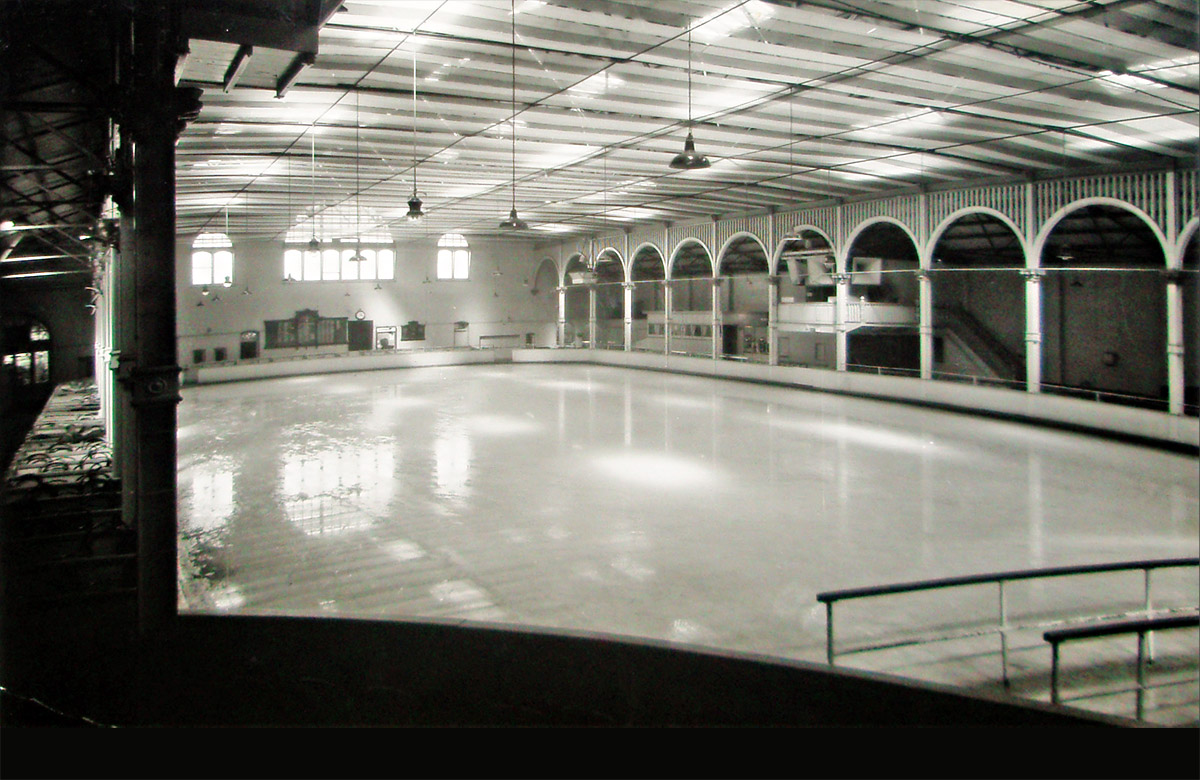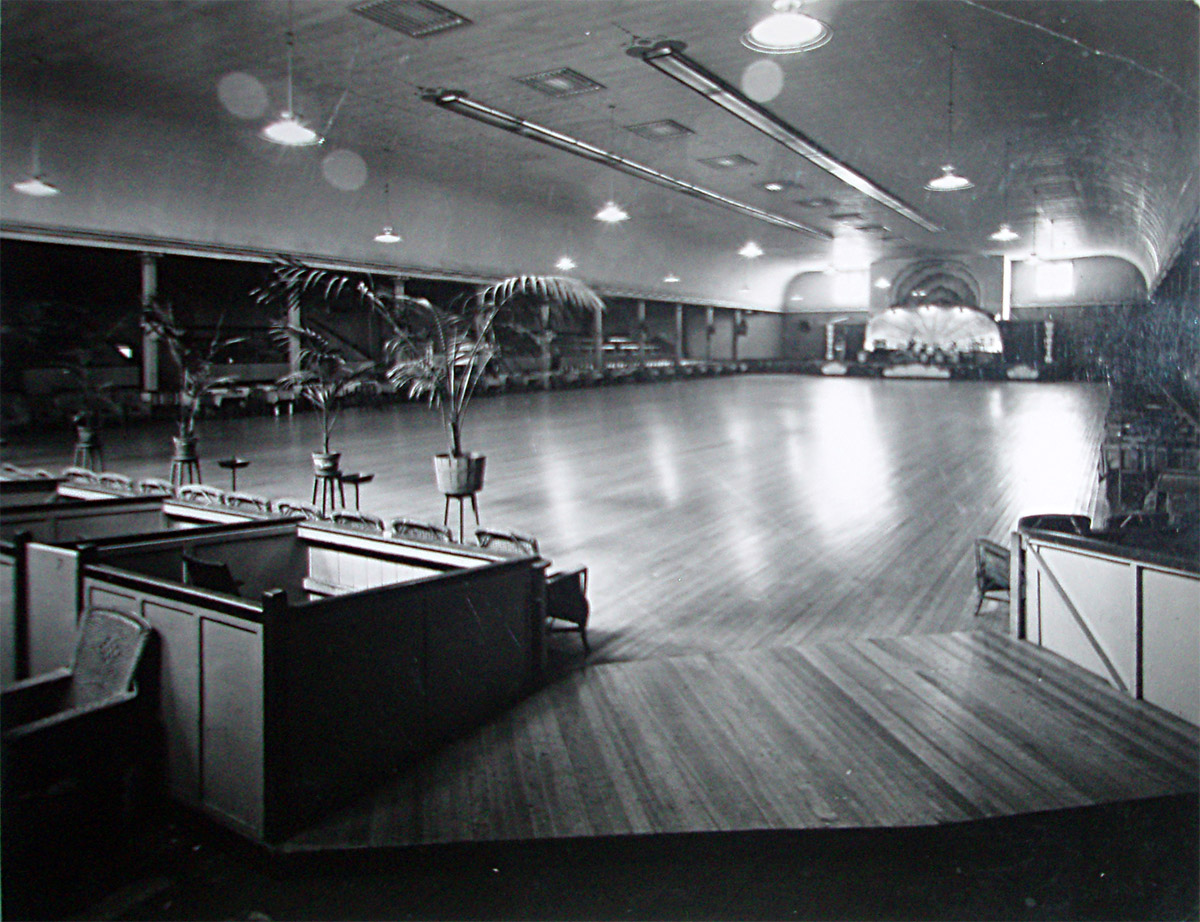
Melbourne Glaciarium and Professor James Brewer. Brewer was a professional instructor from Princes Skating Rink in London where European hockey first began a few years earlier. He trained the first skaters in Adelaide in 1905 and Melbourne in 1906. [5]
Cradle of National Ice Sports
H Newman Reid and Melbourne Glaciarium
Everything connected with the Glaciarium and cold storage has been constructed under the supervision of Mr. H. Newman Reid, the company's engineer, and the solidity and exactness with which it has been carried out is highly creditable to him.
— The Leader newspaper, Melbourne, 6 June 1906. [3] Melbourne Glaciarium on City Road in 1939 after a major addition (far left) and refurbishment. It was a "short walk across Princes Bridge". [15]
Melbourne Glaciarium on City Road in 1939 after a major addition (far left) and refurbishment. It was a "short walk across Princes Bridge". [15]
VICTORIA'S ASSOCIATION WITH ICE HOCKEY is long, and deep. Long, because the first Canadian-rules game in Australia was played in Melbourne in 1907 against a Canadian team. Deep, because the Victorian Amateur Ice Hockey Association — the first controlling authority for any ice sport in Australia — was organised in Melbourne in 1908, the same year as the International federation. And also because winter sport success, or a lack of it, means a lot on the driest continent with no natural ice … means a lot to a small country with a big sporting reputation.
Henry Newman Reid, the founder of Australian ice hockey, was born near London, and moved to Melbourne with his family at the age of two. The first generation of Reids arrived in Melbourne just twenty years after it was founded. This family’s eminence — their imperial connections, strong business and social bonds, and access to capital — was crucial to the success of Australia’s first ice rinks in three States. In the years leading up to their construction, Reid’s uncle, Robert, was a successful politician and a foremost commercial magnate, with head offices in London — then the International centre of ice skating excellence — and branches in Glasgow and most Australian States.
Ice sports here were indeed as remote as could be from their International centres of excellence. Yet, it was this that made them unique, because the requirement for engineered ice forced a kind of fierce self-sufficiency and ingenuity which was simply without precedent in sport. There were no frozen ponds; Reid's first rinks were spin-offs of the world’s first commercial ice technology. Invented in Victoria in the late-1850s, it developed to export Victorian meat to Europe in the world’s first refrigerated ships in the mid-1870s, against the vested interests of importers of natural ice from North America.
Robert Reid, by then a minister in the Patterson government, promoted this new trade in refrigerated shipping in Britain and North America, including lectures in Ontario, Toronto and Vancouver in 1893 and '94, when the first Stanley Cup was presented. The Stanley family returned to England that year, where Lord Stanley became Mayor of Liverpool and his sons helped establish ice hockey. Back home, late in 1893, the "frozen heart" of the commercial ice pioneer, James Harrison, finally came to rest, and the grand era of ice rinks dawned.
The first mechanically-frozen indoor ice rink in North America was the North Avenue Ice Palace built in 1894 at Baltimore, Maryland, where organised hockey in America started late that year. The National Skating Palace also opened the same year in today's London Palladium. They were followed in 1895 by Schenley Park Casino in Pittsburgh; Niagara Hall Ice Rink in London; and St Nicholas Rink in New York. In 1896 came the double-width Washington Convention Hall; the new Dey's Arena in Ottawa; and the Prince's Skating Club in London, which supplied Australia's first International professional skating instructor, James Brewer, the world's professional skating champion.
Back in Australia, Henry Reid commenced planning of the experimental, donut-shaped Adelaide rink shortly after, well-aware of these developments. He opened it in late-1904, then sold his interest eighteen months later. It survived under new management until the end of the winter of 1908. Melbourne Glaciarium opened with Reid as managing director for the Winter of 1906, little more than a decade after the commencement of the new wave of engineered ice to the north. At 180 by 90-ft with seating for thousands, it was the third-largest, multi-functional ice arena in the world, as its builders well-knew. It was followed the next year by the smaller Sydney Glaciarium, and with it, the essential hardware for National and International ice hockey and skating competition.
Reid engaged architects Ussher and Kemp for the Melbourne rink and cold store complex, a practice well-known for their Federation mansions. The chosen site was part of the Princes Court entertainment precinct opposite Wirth's Roller Rink and Fitzgerald's Circus at the city's main gateway. Positioned at today's Southbank where the southern Southgate tower now stands, the two-storey solid brick structure covered a block measuring 30.5 x 61m with frontages to both City Road and the Yarra bank road. It cost about $6.4m in today's money.
The City Road façade was boldly designed in brick and tinted cement similar to Flinders Street Station across the river, and there was a wide entrance hall at the corner nearest Princes Bridge. [2] Geoff Henke used to walk down there at lunchtime from Molony's in the city to see Olympian Gwen Molony training in the years before they were married. [6]
Reid's company mainly aimed to provide cold storage accommodation for exporters and shippers of Victoria's rapidly increasing overseas trade in foodstuffs. The whole of the basement space was set apart for storage partitioned off into compartments where exporters could store their produce. It had a holding capacity of 5,000 tons accessible from all four sides and the whole space was intersected with tram roads and cartways.
The floor of the ice rink overhead was built of layers of different materials through which ran the grid of pipes carrying ammonia that kept the floor frozen. Reid had zoned it such that any sign of thaw rang a telephone bell, indicating to the engineer below that a certain pipe needed opening a point or so, enabling that section to be immediately frozen hard. [3]
The ice surface, 54.9m long by 27.4m wide with splayed corners, was the size and shape of an ice hockey rink. [2, 5] It was in a double height space with an exposed steel trussed-roof supported on a steel column grid each side of the ice floor. The space was "artistically decorated with flags, flowers and ferns, and brilliantly lit by electricity". The rink was enclosed by boards to handrail height with a rail on top and an open frame of steel arches between the columns supporting the roof which recalled the fretwork of a verandah on a large Federation home. Loges (private boxes) of two rows of reserved seats for carnivals were located each side. These were warmed by a network of hot-water pipes running beneath the carpeted floor.
Small tables were located close to the refreshment buffet and beneath the elevated bandstand on the east side. On the west side, behind the reserved seats was a wide promenade, and behind this again rose several tiers of seats for the use of the public. One section was set apart as a "smokers' retreat," and the seats were so arranged that a full view of the skating surface could be obtained from any seat in the building. To the left of the main entrance were the administrative offices, the ladies' and gentlemen's rooms, each provided with an office for the supply of skates, and furnished sumptuously. [2]
The power necessary to keep everything going was a compact 100-ton engine plant. The condensing plant was connected with the river, the water being drawn from and returned there. Filtered Yan Yean water was used for ice making. Reid intended to run a a tramway right down to the Yarra River, so that the goods of exporters could be easily loaded on board outgoing vessels using barges. In those years, ships came right up the river to a saltwater turning basin overlooked by Old Customs House on Flinders and William, today's Immigration Museum. [3]
The first Australian ice floors were a by-product of ice works, born of necessity in a dry land, pioneered here, and before the International Ice Hockey Federation had even existed. They were world-class, multi-functional arenas, brilliantly conceived as publicly-listed companies, and it is doubtful there was anything quite like them anywhere else in the world. International visitors gazed upon them in wonder. Amateur ice hockey in Australia was born in Melbourne in 1906 and 1907 and, while it was small in scale, it was still comparable to anywhere else.
It was played as an offside game twenty years earlier than almost everywhere else and, as a result, it was highly progressive and innovative by world standards. The first ice hockey games in Europe were played at the Prince's Skating Club in Knightsbridge, England, in 1902 [4] and it was from there that Australia's first skaters were trained by one of its instructors, James Brewer, who had taught in Adelaide and exhibited on opening night in Melbourne. He was joined in Melbourne by Professor W Chambers, also from Princes.
The sport here was linked directly to the very foundations of the modern North American game, through Herb Blatchly, Bobbie Jackson and Jack Goodall. A branch of the Goodall family built a merchant shipping dynasty. Their vessels plied the Pacific all along the West Coast, between California, British Columbia, Washington, and Alaska, and it was these centres that most influenced Australian ice sports. Despite the vast physical and psychological distances that separated them, Australia, Canada and the United States were and still are parallel nations. [1]
CITATIONS
![]()
1. Ice Hockey Victoria Centenary Video, Ross Carpenter, September 2009.
2. The Argus, Melbourne, Sat 9 Jun 1906 p 16. The 'Glaciarium' Real Ice Skating Rink.
3. The Leader, Melbourne, Sat 6 June 1906 p 33. The Glaciarium.
4. iihf.com history page, last accessed April 2016.
5. It was not until 1925 that the LIGH congress (today's IIHF) decided to set a minimum rink size for international tournaments: 50 x 18m (164 x 59ft) — about half the size of a bandy field and smaller than the standard NHL rink. The standard LIGH rink was set to 56 x 26m (184 x 85ft).
6. Sydney Morning Herald Good Weekend, August 15 2015, 'Two of us: Geoff and Gweneth Henke' by Robyn Doreian.
7. Beryl Black Archive.
8. Coloured postcard courtesy State Library Victoria. Image first published in Punch, Melbourne, 14 June 1906, p 14. The opening of the Glaciarium or real ice skating rink.










